


Printed Book of Hours (Use of Rome)
, France, Paris, Gilles and Germaine Hardouyn, 1518






Printed Book of Hours (Use of Rome)
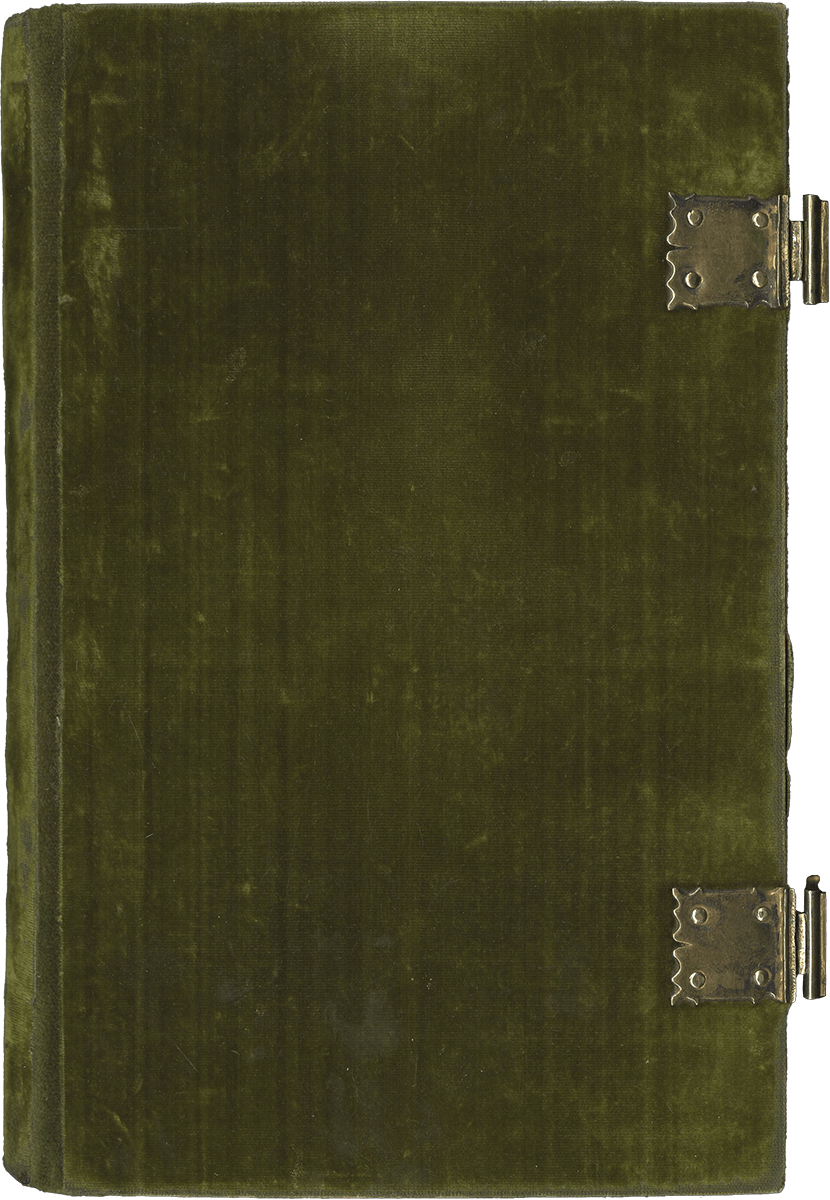


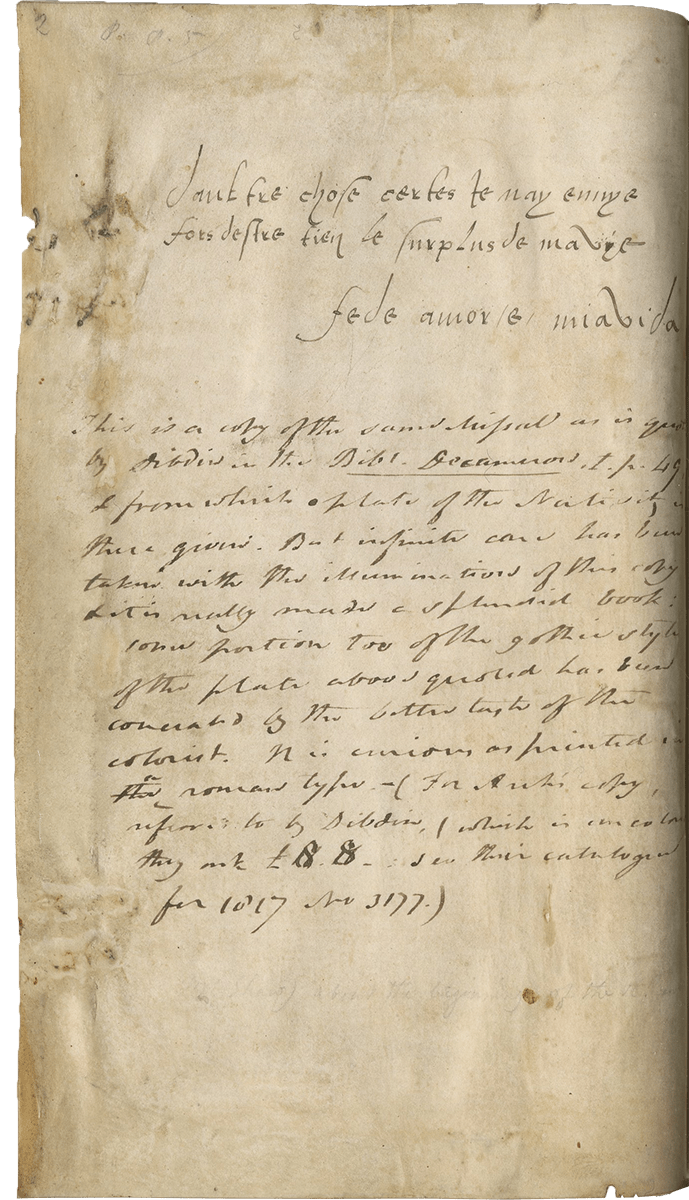
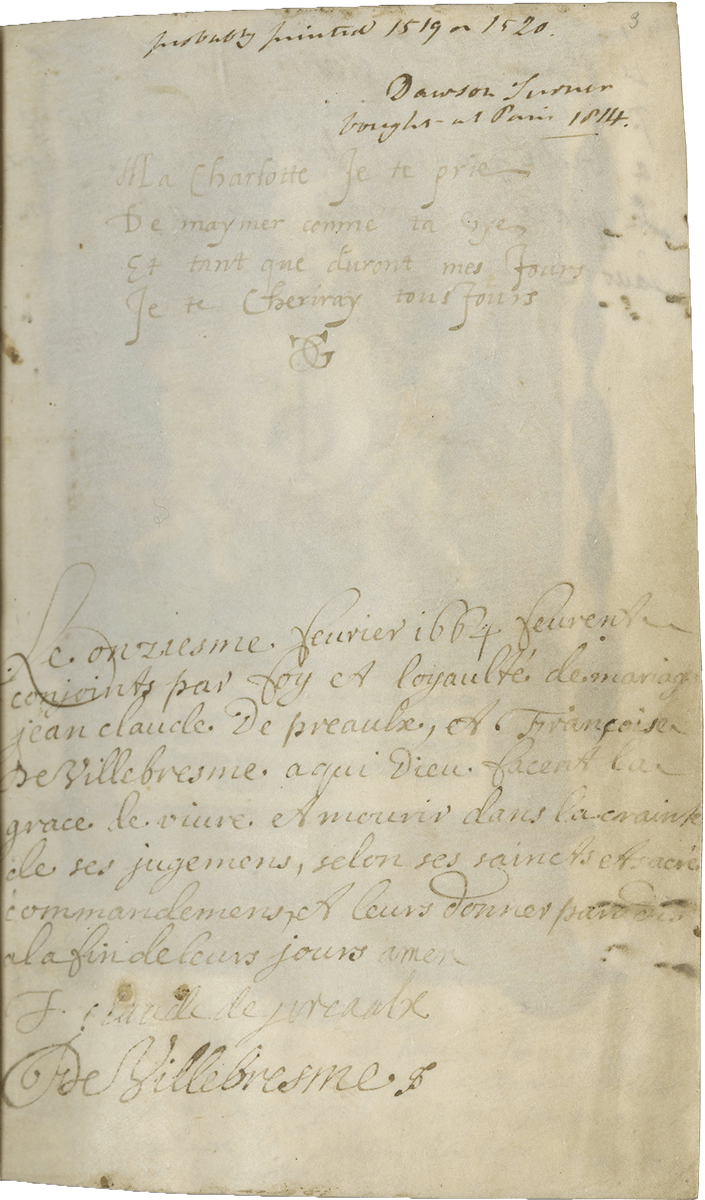
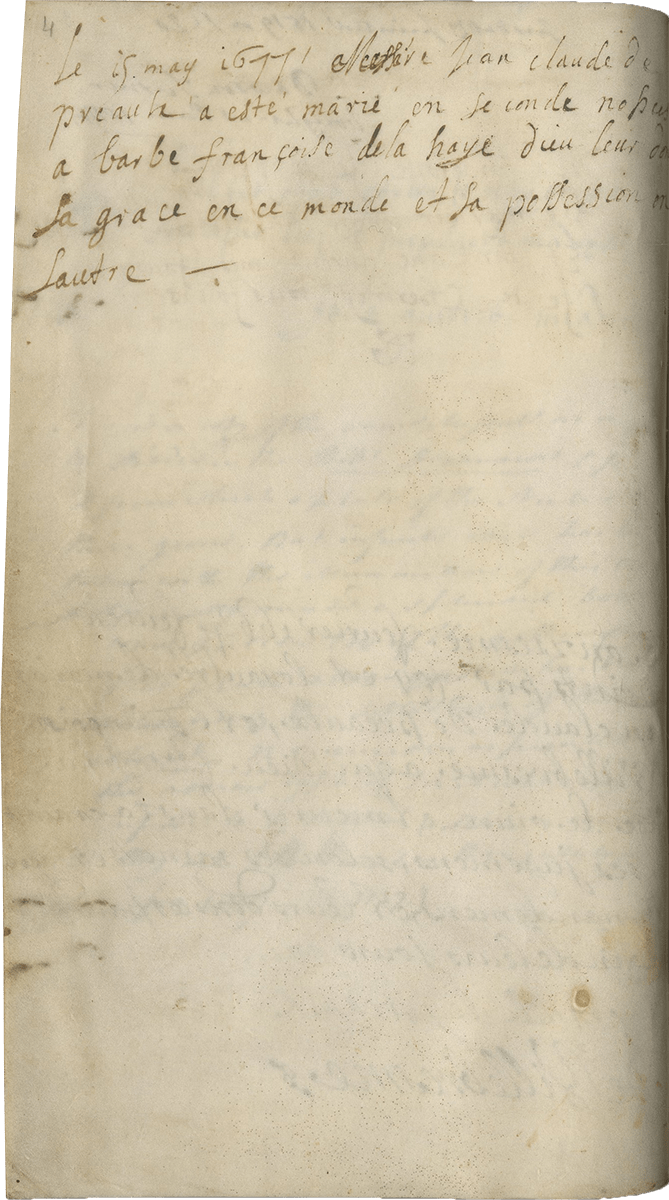
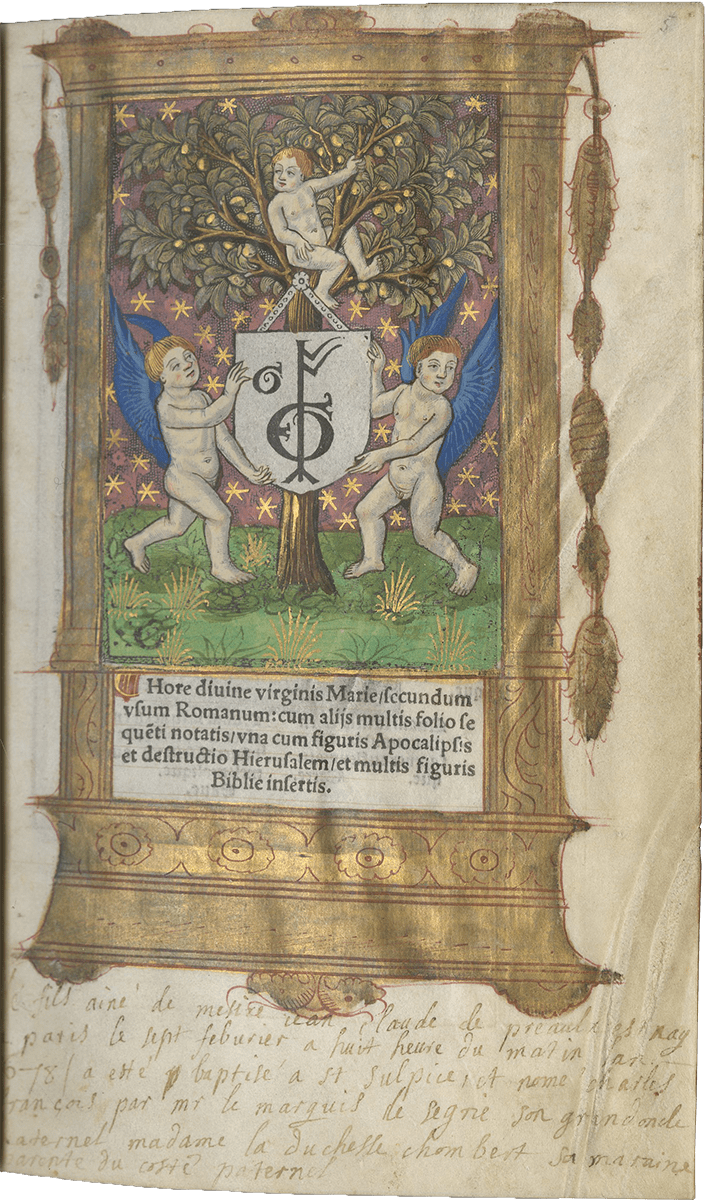
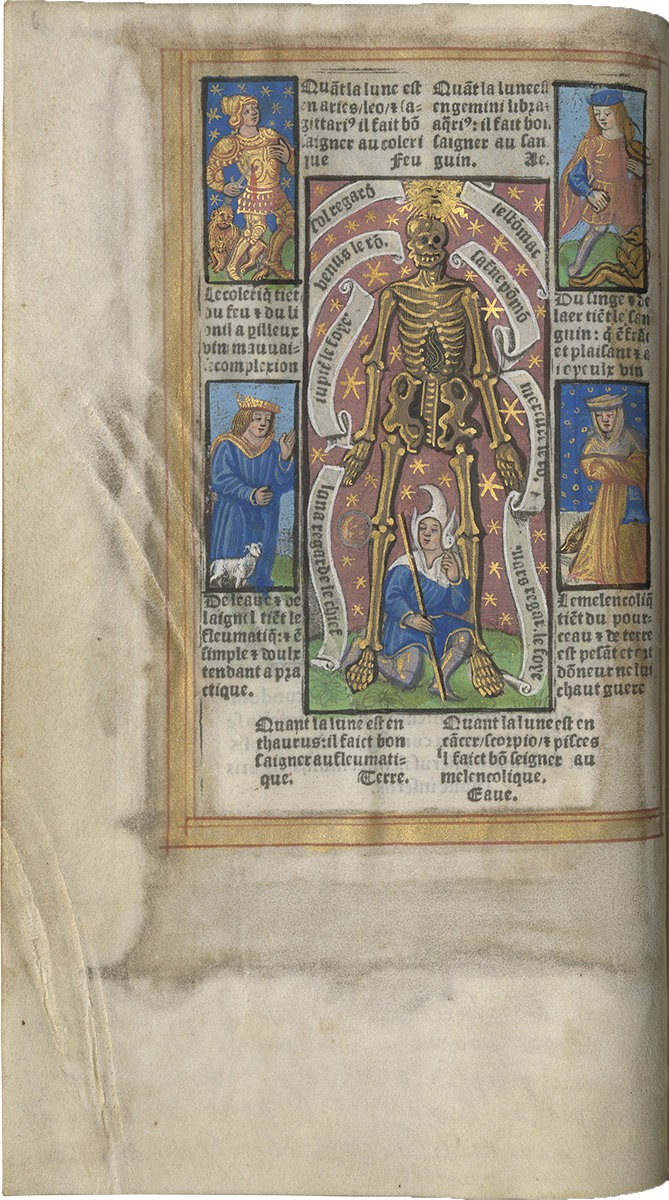
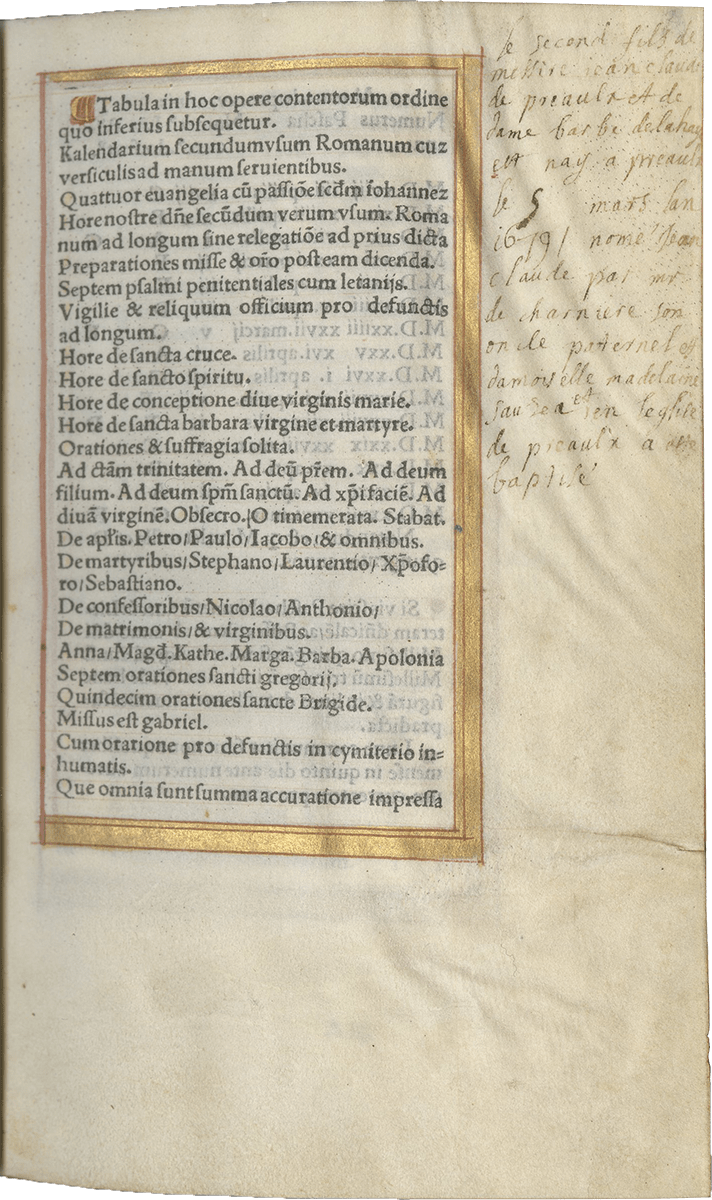
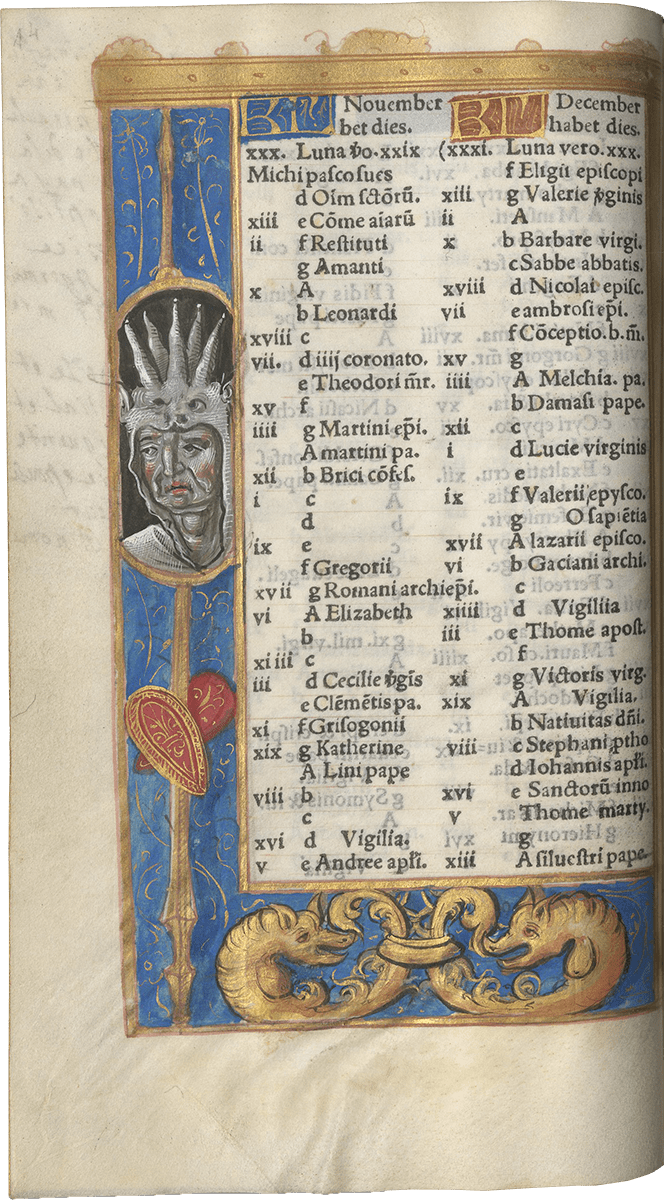

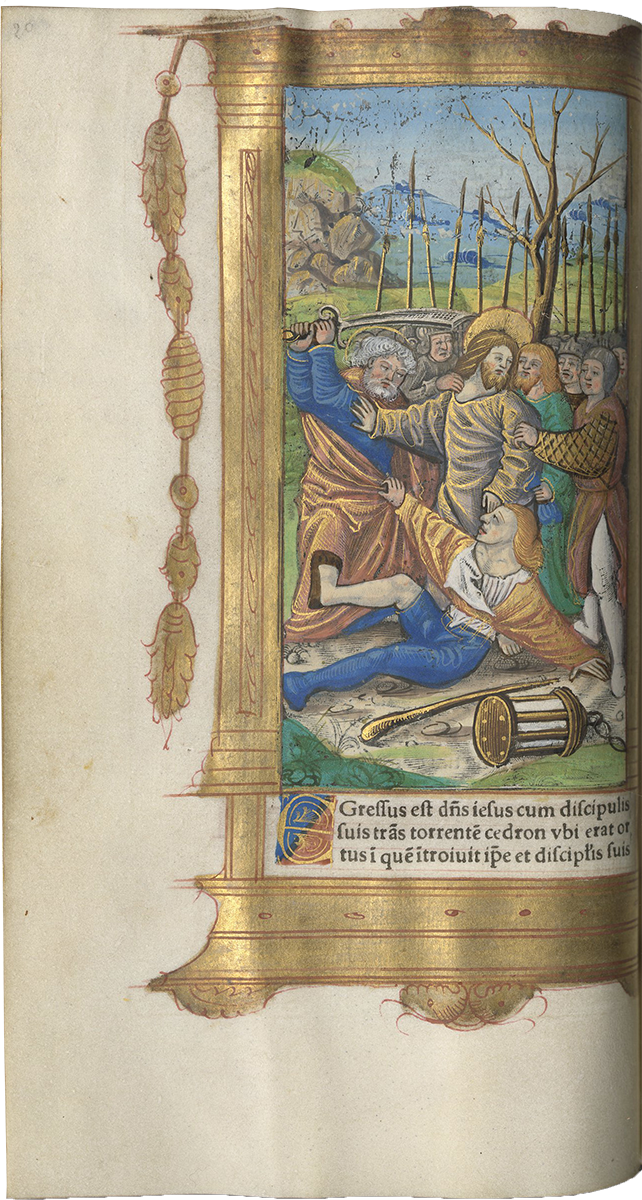
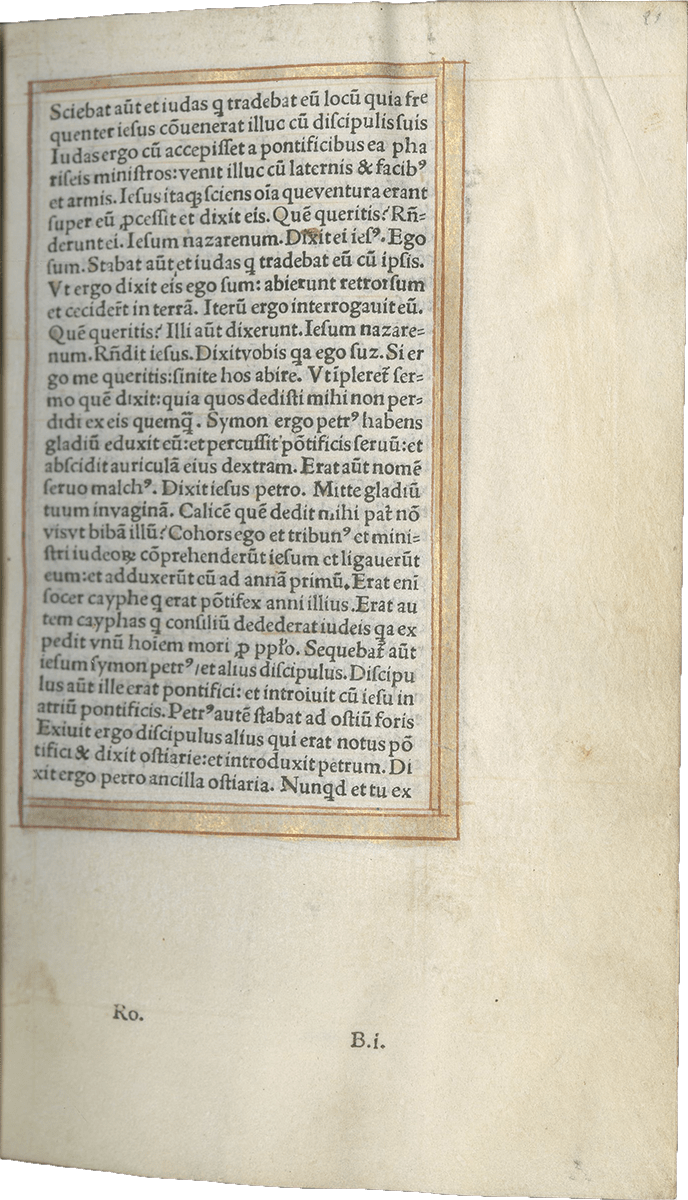
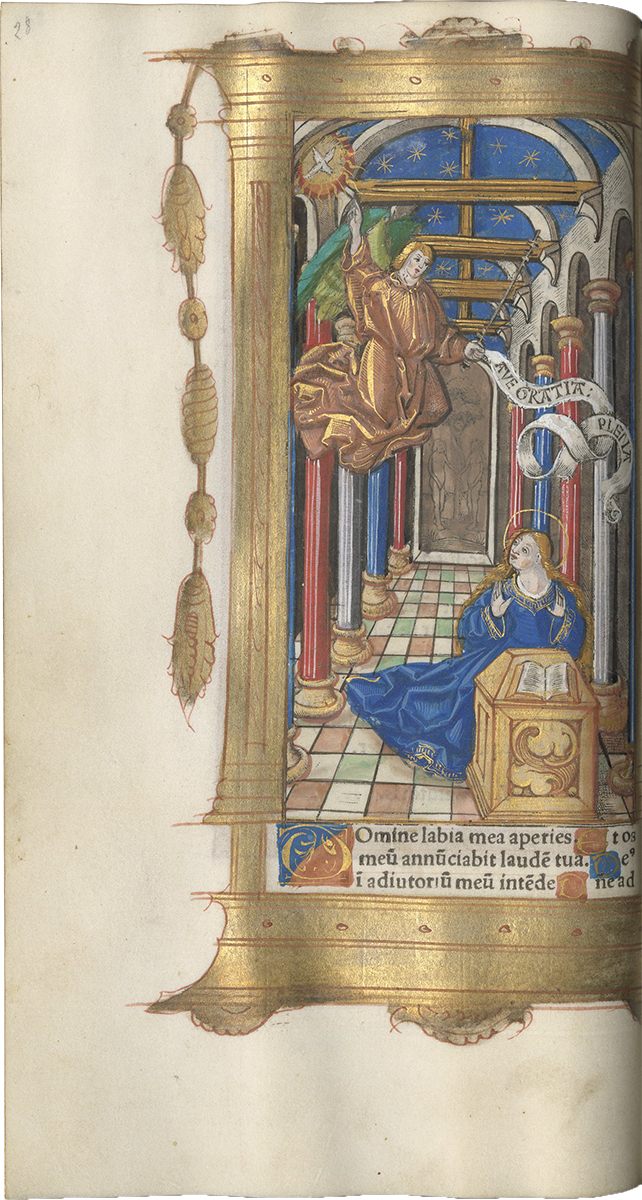
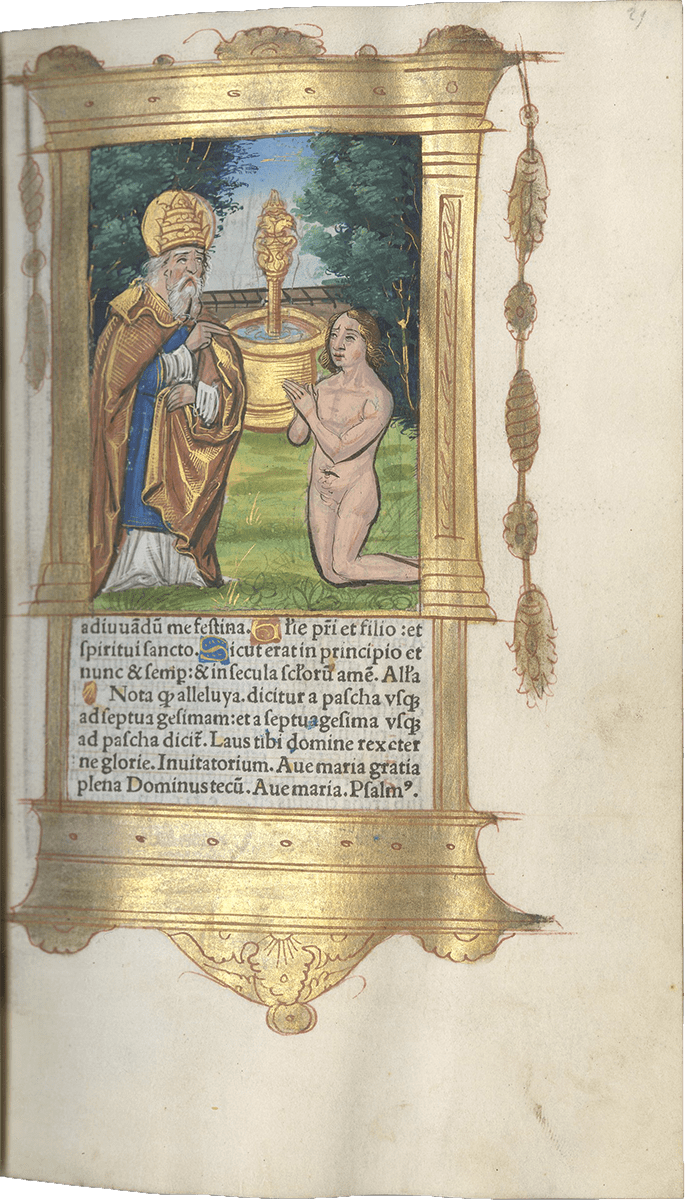





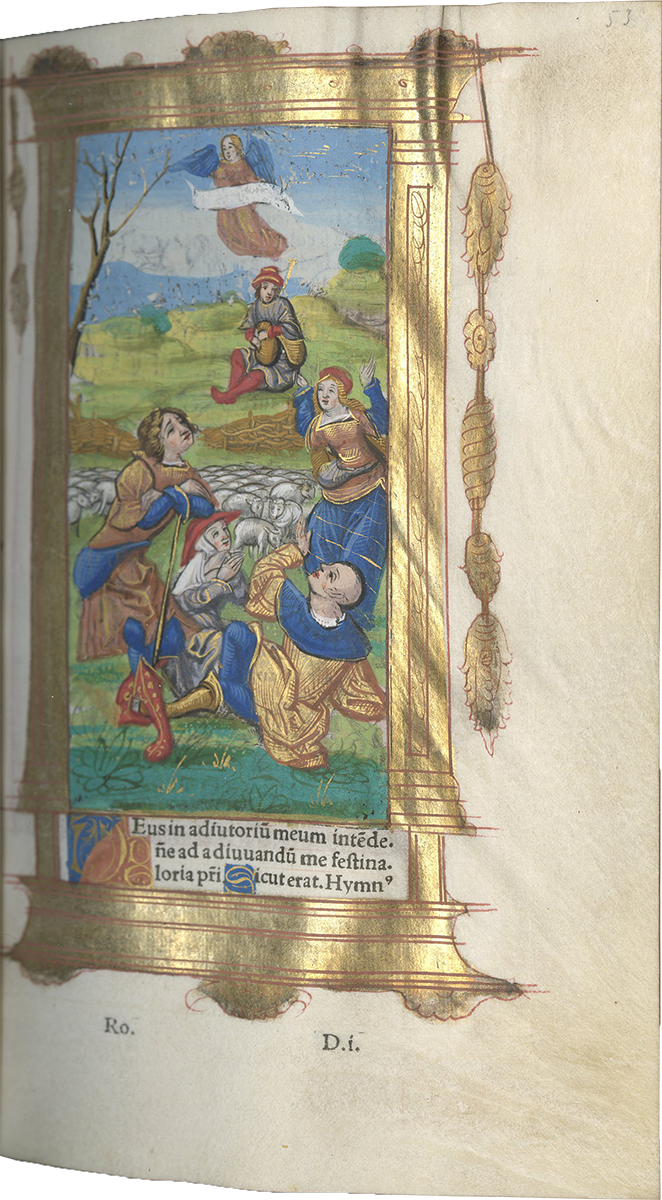





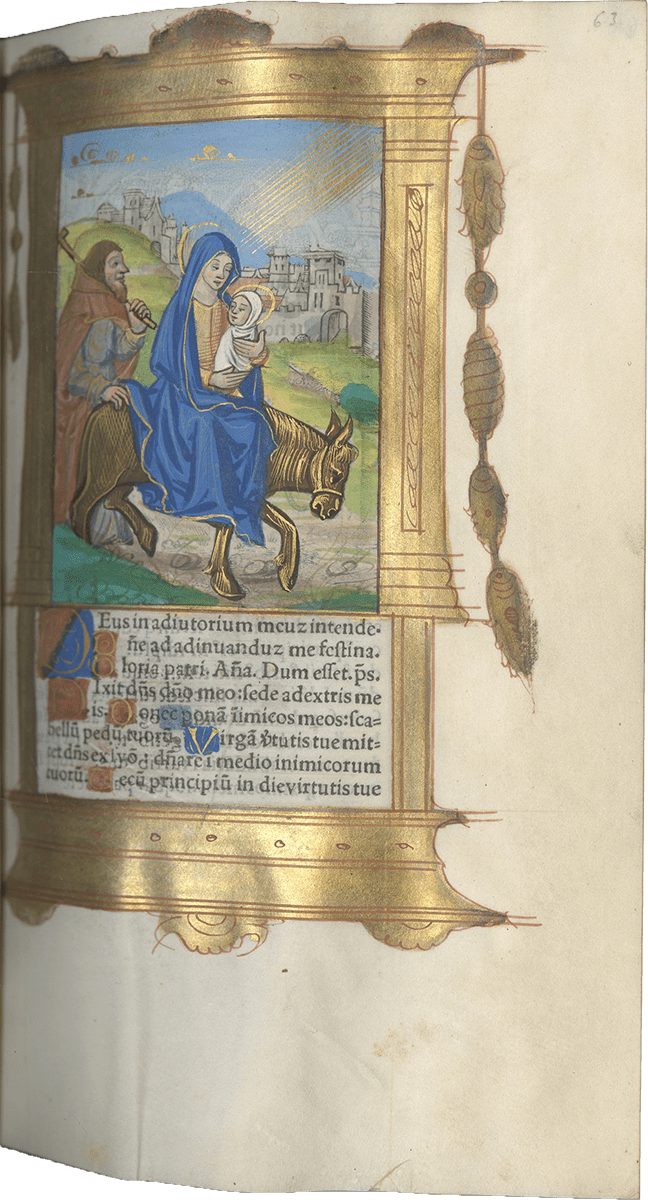


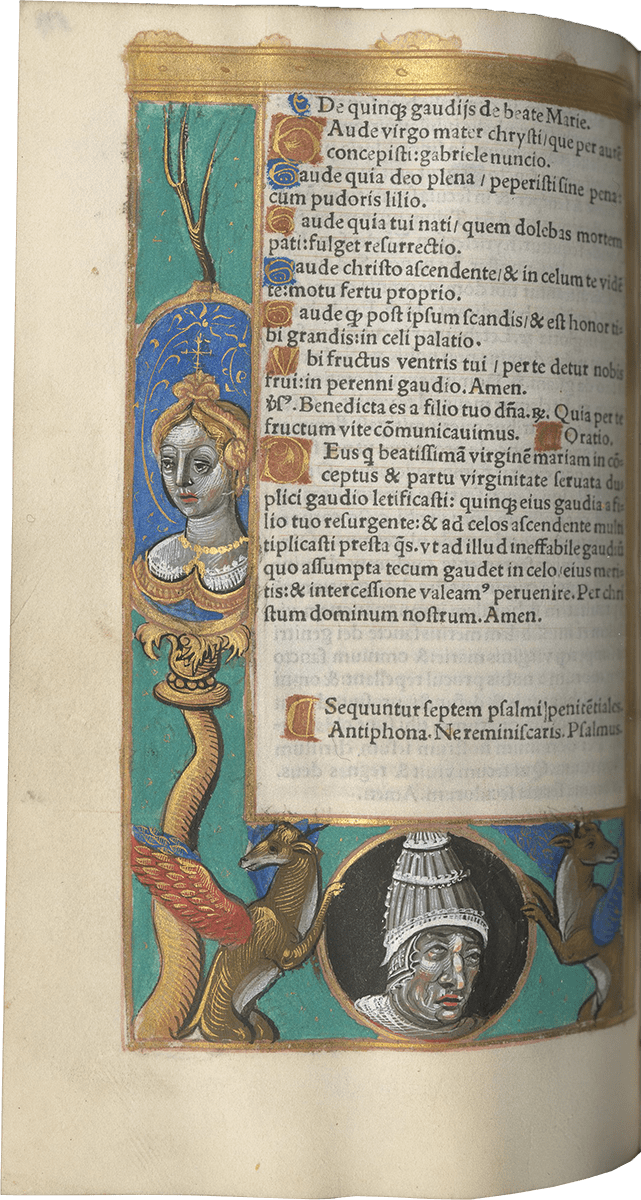

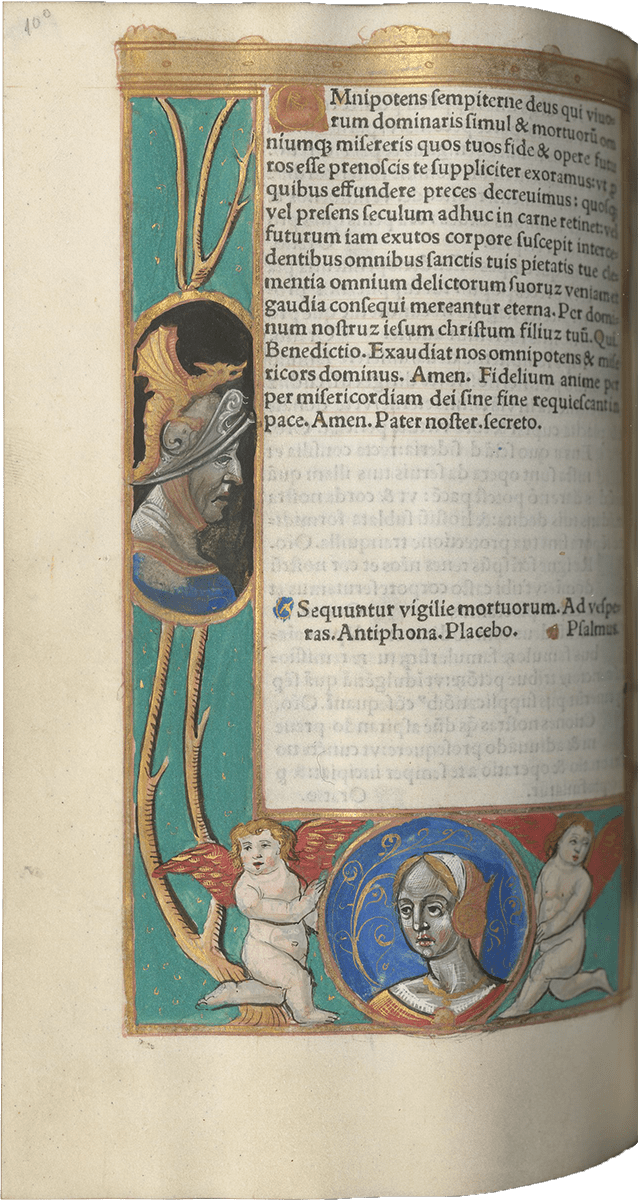
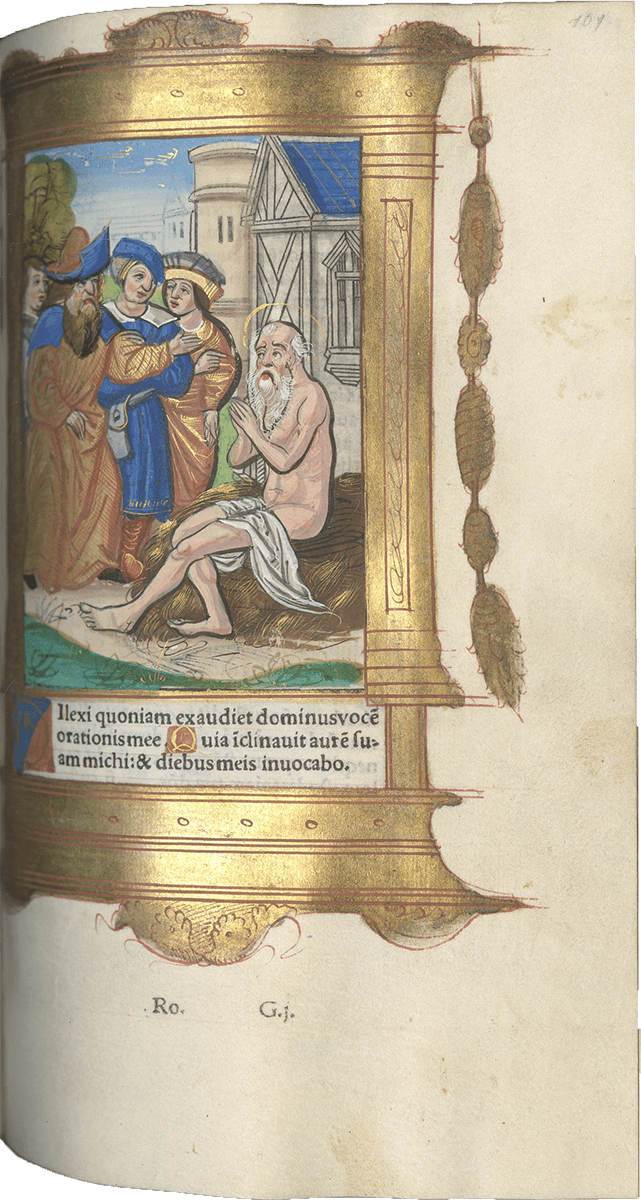



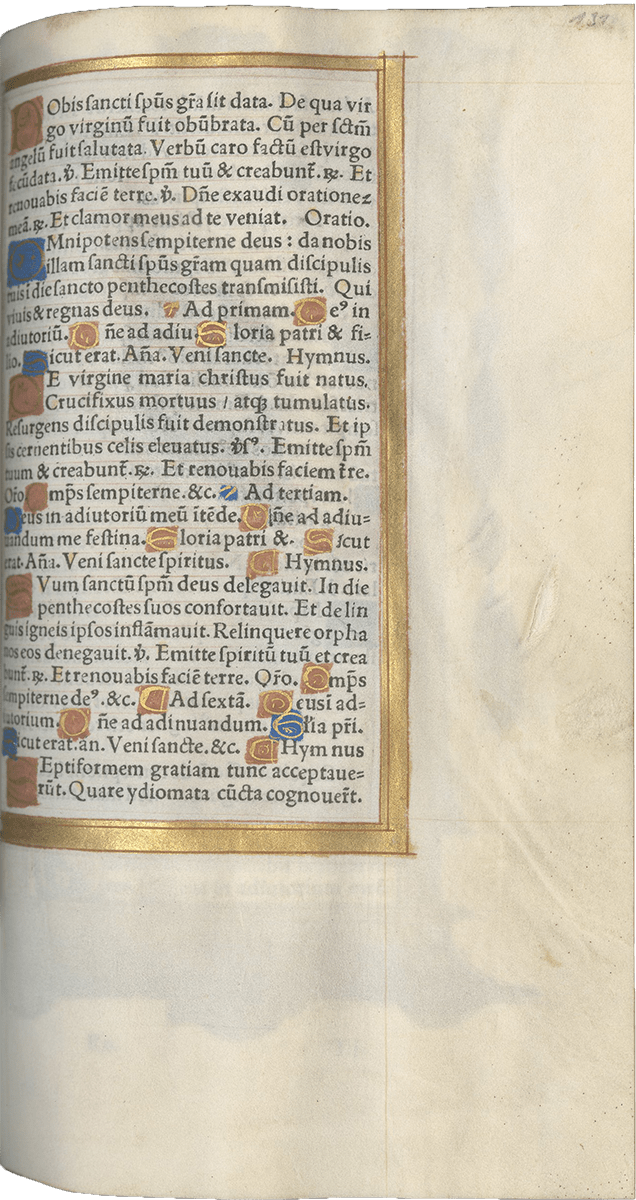
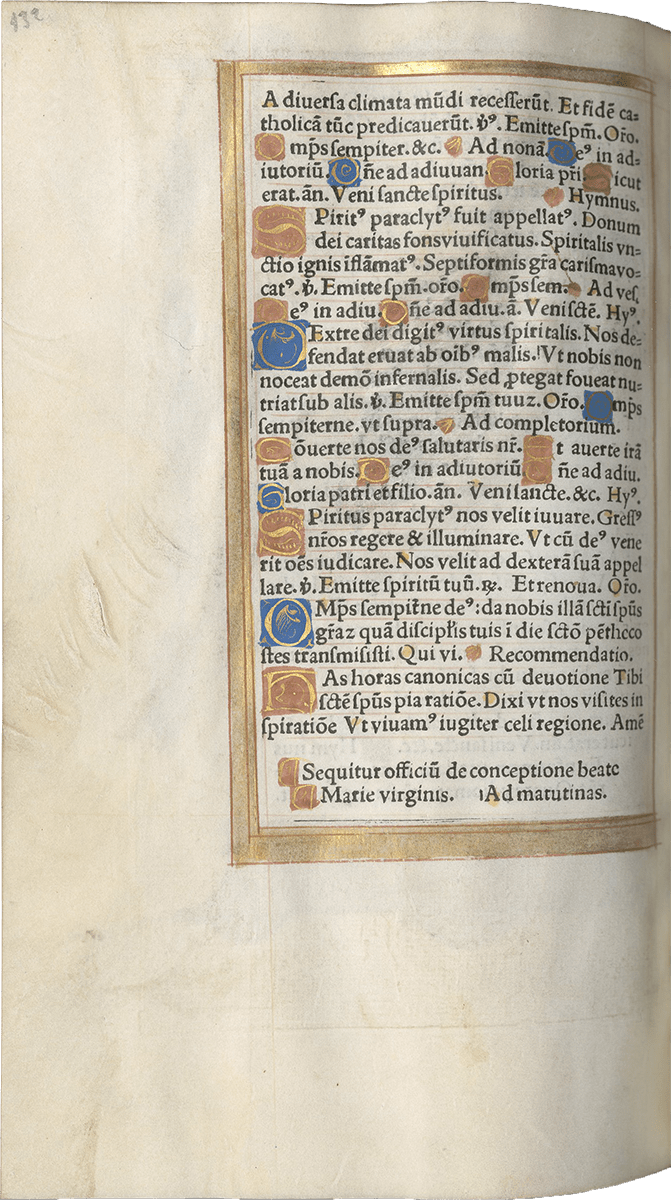
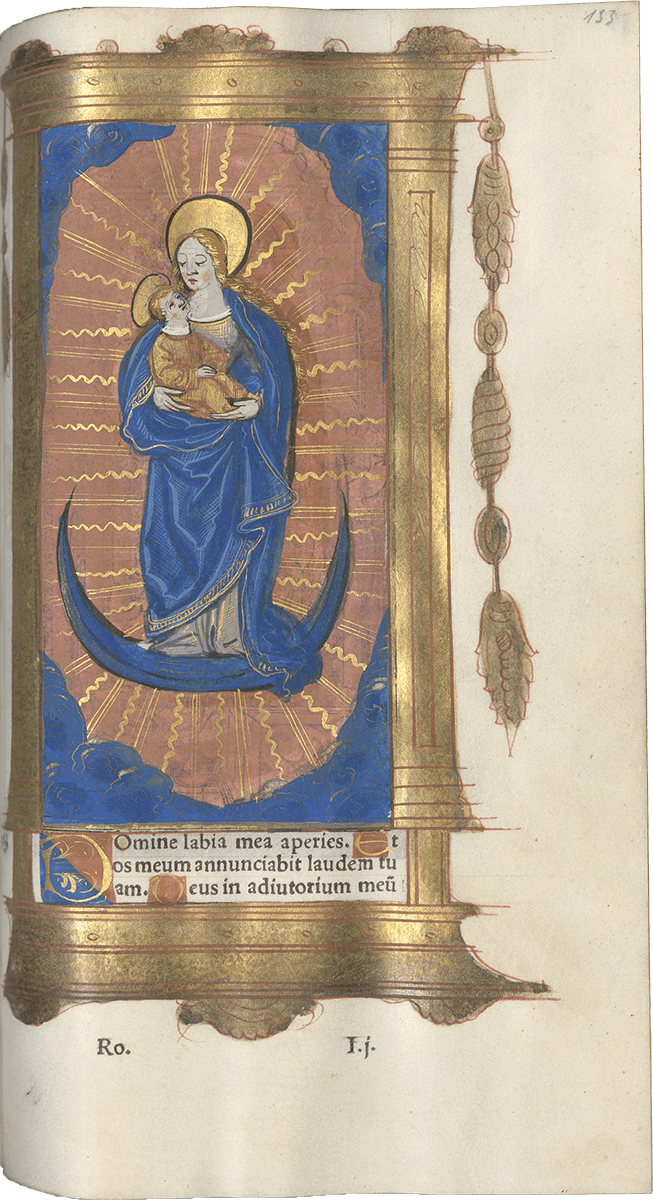



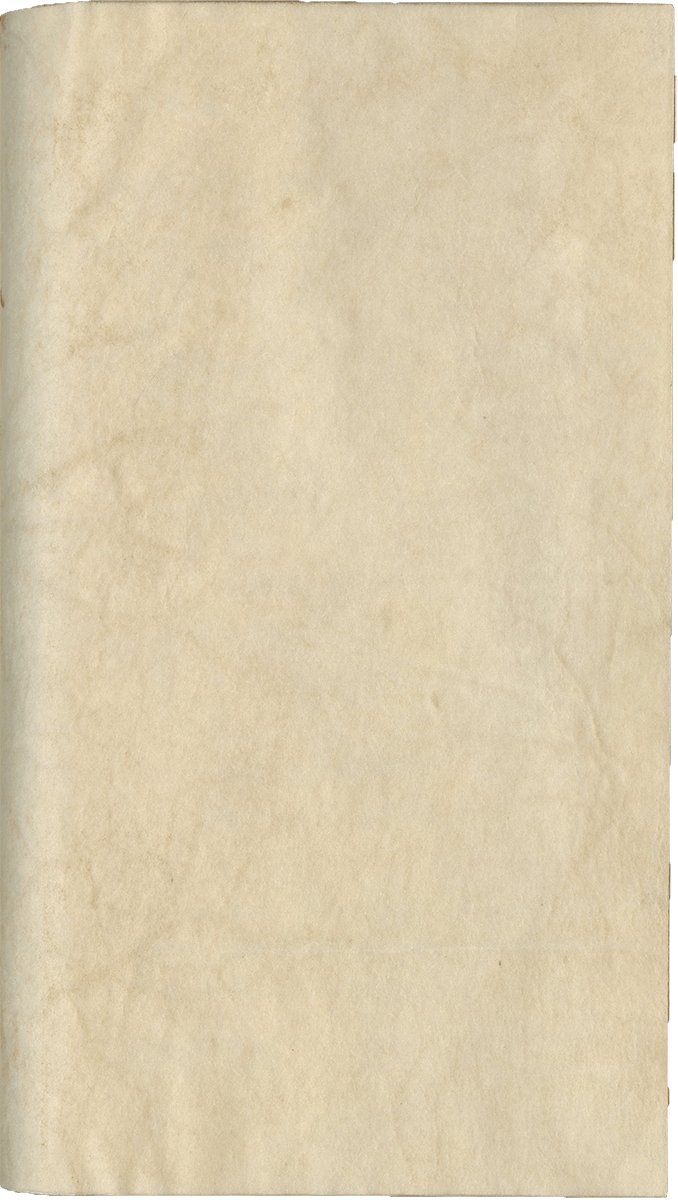
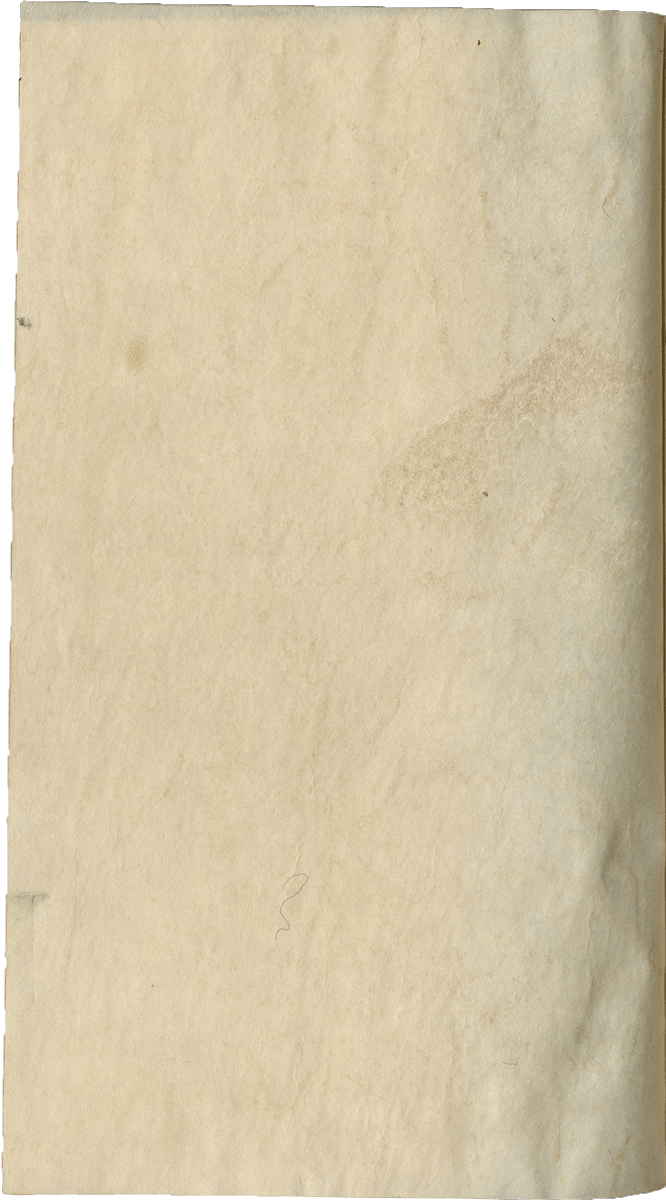

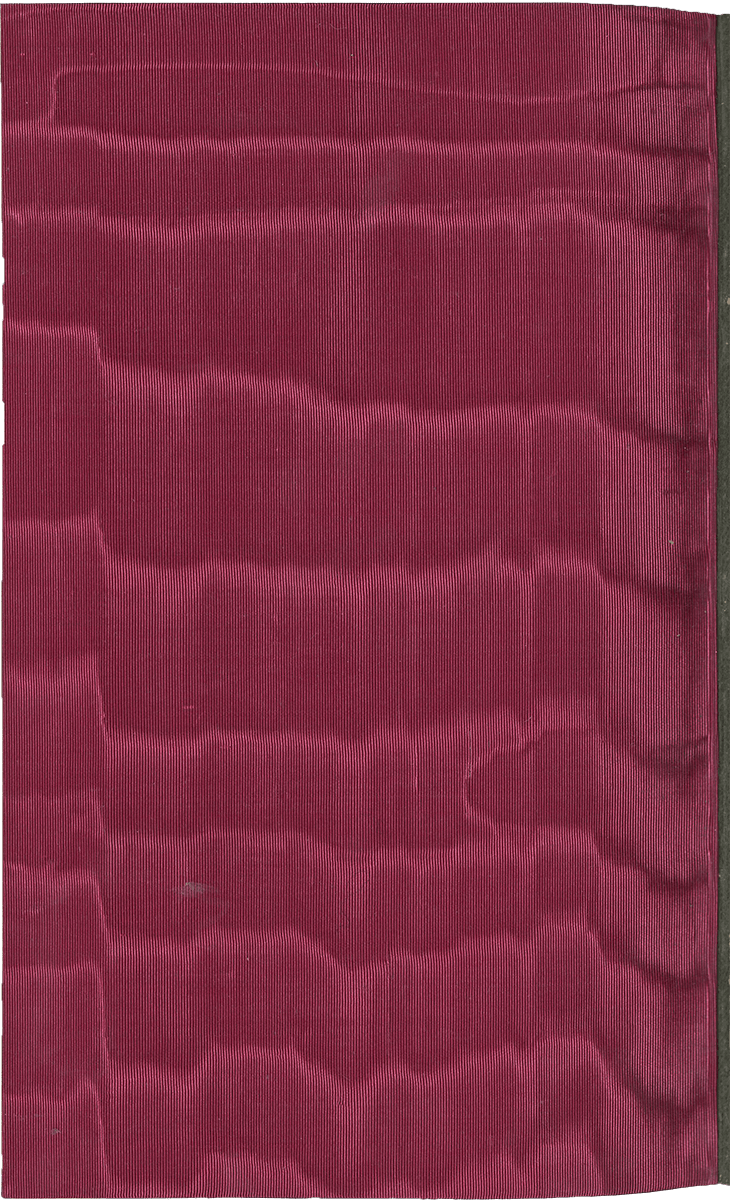
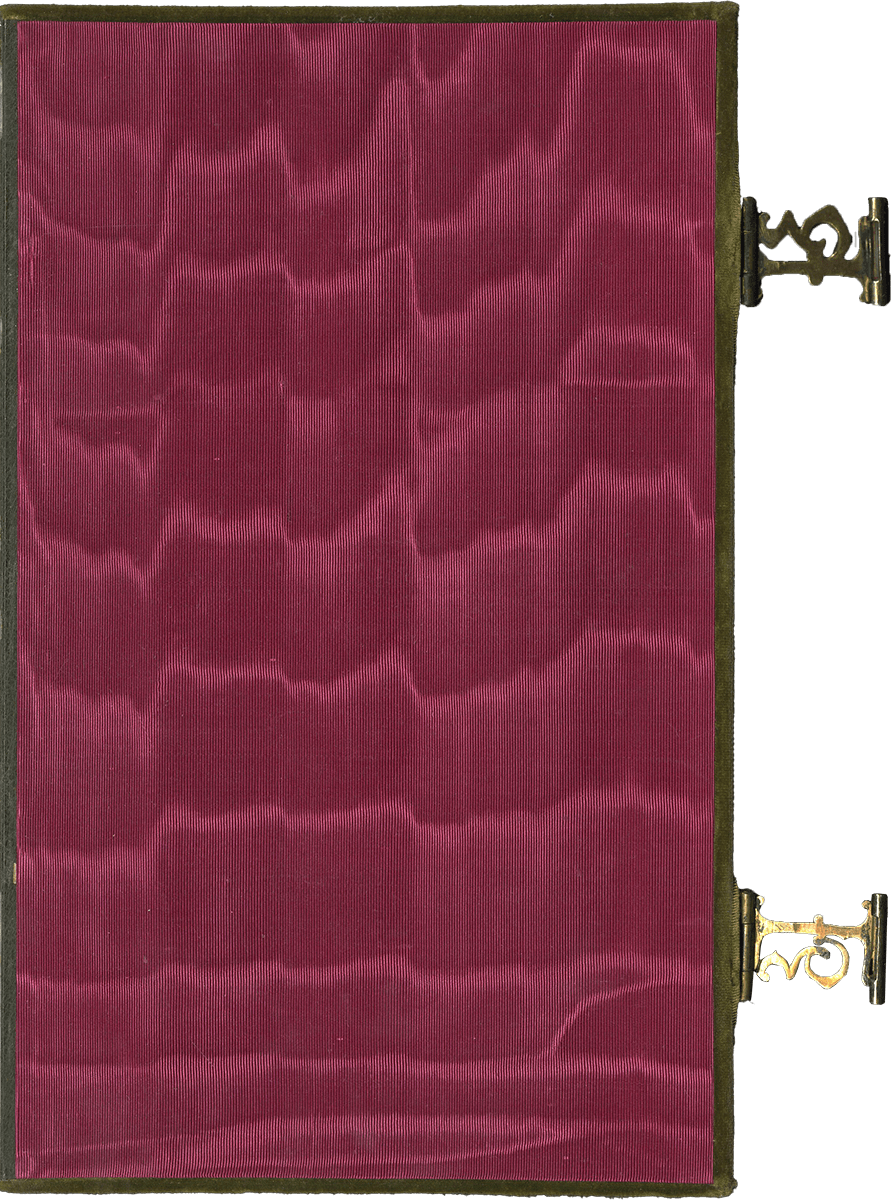
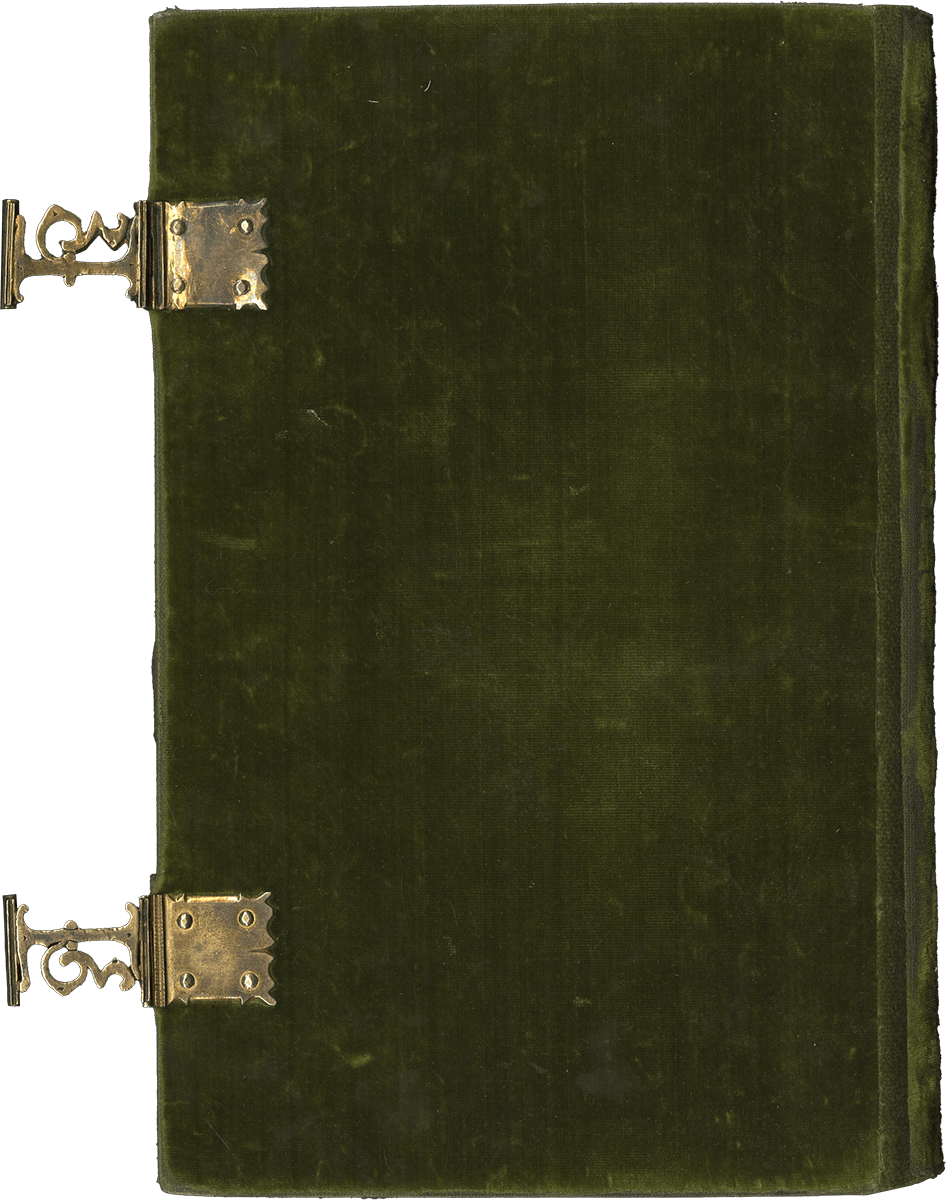
Description
Paris was the epicenter of the production of printed books of Hours from 1485 to nearly 1550. Many of these imprints, like this rare example, consciously imitated illuminated manuscripts. In this particularly appealing volume over three dozen metalcuts are so vibrantly and expertly painted that they are practically indistinguishable from illuminated miniatures. Further illuminated borders added on blank parchment imitate grisaille cameos, as found in many Italian manuscripts, and suggest a woman commissioner who appears in three of the four borders. Later annotations prove this book to have been a prized possession in a French noble house for generations.
84 folios, paginated in modern pencil, (collation: A-K8, L4, alphanumerical quire signatures on recto of third and fourth leaves in quire A, signatures on recto of first three leaves of quire B, signatures on recto of first four leaves of quires C—K, L signatures on recto of first two leaves), complete, thirty-one lines printed in Roman font in black ink, (justification 133 x 77 mm), single-, double-, and triple-line initials in gold paint on alternating red and blue grounds, sixteen full and half-page metal-cut prints, hand-painted with primarily blue, green, and red, with gold embellishments, miniatures framed by gold bands or painted gold doric-style architectural borders that frame text below images, with added gold decoration around borders, twenty-two smaller metalcuts, illuminated similarly, four pages with illuminated borders over bare parchment (ff. A5v, F1v, F8v, H6) some folios with wear, discoloration, and minor damage from handling, pairs of parchment flyleaves front and back single, added during rebinding, paper flyleaves pasted to scarlet watered silk pastedown bifolia inside front and back covers. Nineteenth- or twentieth-century green velvet binding with two gilt clasps. Dimensions 200 x 123 mm.
PROVENANCE
1. Printed in Paris by Germaine Hardouyn in the sixteenth century for use of Rome. The almanac for the year 1518-32 suggests a date of printing c. 1518. Gilles Hardouyn (active c. 1455–1521) and his brother Germaine Hardouyn (active c. 1521–1541), were illuminators, printers, booksellers, and publishers associated with the University of Paris.
2. In an earlier sixteenth-century hand, an unpublished love poem, ending with a line from Jean Meschinot’s “Plainte de la Cité de Nantes,” explicit, “A grief mal pacience forte,” with an erased name not visible under UV (p. 174).
3. In a later sixteenth- or seventeenth-century hand, a near-quotation from the end of Ovid’s fifth epistle on p. 2, “Daultre chose certes te nay envye/ fors destre tien le surplus de may vye” followed by what may be a motto: “fede amor e mia vida.” A similar hand writes the following on p. 3 “Ma Charlotte Je te prie/ De maymer comme ta vye/ Et tant que duront mes Jours/ Je te cheriray tous jours” above a monogram perhaps CG. It is not impossible that this refers to Gilbert de Préaulx, first Marquis de Préaux and his second wife Charlotte de Lavardin (m. 1588).
4. Flyleaves and the margins of the first few leaves covered with family notes concerning Jean-Claude Préaulx, third Marquis de Préaux (1626-1685), beginning with his marriage to Francoise de Villebresme in 1664. Signed by each member of the couple on p. 3. Note on de Préaulx’s second marriage to Barbe de la Haye in 1677 on p. 4. The five sons of de Préaulx and de la Haye were baptized in St. Suplice, faubourg St. Germaine in Paris and their godparents and names listed ff. A1, A2, A3v, A4, A5, and de Préaulx’s death in 1685 is recorded on f. A7. De Préaulx’s heir Joseph (f. A4) served with the earliest Musketeer company.
5. English banker, botanist, and antiquarian (and husband of noted portraitist Mary Dawson Turner) Dawson Turner (1775-1858) noted that he “bought [this book] at Paris in 1814.”
6. Owned by Anglo-American artist and bibliophile, C. Edmund Delbos (1878-1949), inscribed on flyleaf “C. E. DELBOS. Grosse Pointe Village [Michigan], M. Litt. 1930. No. 1431.”
7. Libreria Antiquaria Mediolanum, Via Del Camine 1, 20121 Milano dealer sticker on front flyleaf, possibly their stock number in pencil in lower corner 7C52H and their note NY22 indicating that the book was at the New York Antiquarian Book Fair that year.
TEXT
f. A1, Title-page, “Hore diuine virginis Marie/ secundum vsum Romanum: cum alijs multis folio sequẽti notatis/ vna cum figuris Apocalipsis et destructio Hierusalem/ et multis figuris Biblie insertis”;
f. A1v, Wound man;
f. A2, Table of contents;
f. A2v, Almanac for the years 1518-1532;
ff. A3-5v, Calendar;
ff. A6-B4, Gospel Lessons; John (p. 15); Luke (p. 17); Matthew (p. 18); Mark (p. 19); The Passion from the Gospel of John (p. 20), followed by prayers;
ff. B4v-F1, Hours of the Virgin, use of Rome: Matins (f.B4v); Lauds (f. C2v); Prime (f. C7); Terce (f. D1); Sext (f. D3); None (f. D4v); Vespers (f. D6); Compline (f. D8v);
f. F1v, Fifteen Joys of the Virgin;
f. F2, Seven Penitential Psalms, followed by the Litany and prayers;
f. G1, Office of the Dead;
f. H5v, Short Hours of the Cross;
f. H7v, Short Hours of the Holy Spirit;
f. I1, Short Hours of the Conception of Mary;
f. I3, Lady Mass;
f. I4, Hours of St. Barbara;
f. I6, Prayers, including to the Holy Spirit (f. I6v), to the Holy Face (f. I6v), the Obsecro te (f. I7), O intemerata (f. I8), Stabat Mater (f. K1);
f. K1v, Suffrages to saints, including Michael (f. K1v), John the Baptist (f. K1v), John the Evangelist (f. K2), Saints Peter and Paul (f. K2), Jacob (f. K2v), Stephen (f. K2v), Laurence (f. K3), Christopher (f. K3), Sebastian (f. K3v), George (f. K4), Nicholas (f. K4v), Anthony (f. K4v), Anna (f. K4v), Mary Magdalene (f. K5), Katherine (f. K5), Margaret (f. K5v), Barbara (f. K5v), Appollonia (f. K6);
f. K7, Seven prayers of St. Gregory;
f. K7v, Prayers, including to Mary (f. K7v), for the dead in the cemetery (f. K8v), to St. Roche (f. L1);
f. L2, Prayer of Saint Augustine, incipit, “O dulcissime iesu xpe”;
f. L3v, Prayer to St. Claude, incipit, “O desolatorum consolatorum consolator”;
f. L4v, Colophon: “Finit officum beate Marie virginis/ secundum vsum Romanum...Parisius/ noviter impressum opera Germani Hardouyn/ commorantis ante Palatium regis: ad intersinium diue Margarete.”
Printed Books of Hours were one of the mainstays of the Parisian publishers and printers; well over 2,000 editions were produced between 1488 and 1568. The new technology of printing, at least in theory, introduced Books of Hours, a prayer book for the laity, to a broader audience. Certainly, the growing urban middle class was originally one of the chief purchasers of these books. In practice, many printed Books of Hours were finished by hand; in some cases, so luxuriously that they may have been as expensive as manuscript copies.
ILLUSTRATION
f. A1, Printer’s device of two winged cherubs holding a shield hung from a tree with flowers in background, red-lined gold architectural frame around text;
f. A1v, Skeletal wound man surrounded by small metalcuts of the four humours;
f. A5v, (illuminated over bare parchment) decorative blue border containing gold dolphins, a gold jousting lance and two crossed red shields, and a face of a man in a demon-like hood in an inset roundel;
f. A6, John on Patmos with an eagle, and a vision of the Virgin and Child in the sky depicted as Virgin on the Crescent Moon;
f. A7, (13-line) St. Luke at a desk, writing his Gospel, with his bull seated underneath;
f. A7v, (13-line) St. Matthew at a desk, writing his Gospel and speaking with an angel;
f. A8, (8-line) St. Mark, copying on a scroll across his lap, with his lion seated nearby;
f. A8v, The Betrayal;
f. B4v, The Annunciation with the angel Gabriel pointing to the Holy Spirit and scroll reaching down to the Virgin Mary, kneeling at a prie dieu in front of a painting of Adam, Eve, and the Serpent before the Tree of Knowledge;
f. B5, Creation of Adam;
f. C2v, The Visitation of Saint Elizabeth and the Virgin Mary, the Holy Spirit descends as rays of light onto a barren tree in the background;
f. C7, The Nativity with the Virgin Mary and Saint Joseph adoring the Infant Christ;
f. D1, The Annunciation to five shepherds, one playing bagpipes, tending a flock;
f. D3, The Adoration of the Magi;
f. D4v, Presentation in the Temple;
f. D5, Flight into Egypt;
f. D7v, Coronation of the Virgin;
f. F1v, (illuminated over bare parchment) vivid blue-green border featuring two roundels, one with a woman’s head, out of which grows a barren branch, and one of which features either a bishop, abbot, or fool, with winged deer supporters;
f. F2, David spies on Bathsheba in her bath with female attendant;
f. F8v, (illuminated over bare parchment) vivid blue-green border featuring two roundels, one depicting a woman supported by putti, the other of a man in a jousting helm (or fancifully as an ancient Roman knight). The barren branch extends past the man’s roundel;
f. G1, Job seated on a dung heap, witnessed by a group of men;
f. H5v, The Crucifixion with the Virgin Mary and Saint John;
f. H6, (illuminated over bare parchment) vivid blue border with two roundels, one depicting a woman gazing toward the facing Crucifixion, this roundel supported by two fools. The second roundel depicts a man classically dressed and wearing an olive crown;
f. H7v, Pentecost with the Holy Spirit above the heads of the Virgin Mary and the apostles;
f. I1, The Virgin and Child as the Virgin on the Crescent Moon;
f. I3, (8-line) Annunciation;
f. I4v, (12-line) Martyrdom of St. Barbara, Barbara beheaded by a man with a sword;
f. I6, (15-line) God the Father in Majesty; (9-line) Man of Sorrows;
f. I6v, (8-line) Mary praying with two apostles;
f. I7, (13-line) Annunciation;
f. K1v, (10-line) St. Michael Killing the Dragon;
f. K2, (11-line) St. John the Evangelist holding his chalice, (11-line), Saints Peter and Paul holding sword and book;
f. K2v, (11-line) St. Jacob;
f. K3, (11-line) St. Lawrence, holding a book and the griddle;
f. K3v, (11-line) St. Sebastian tied to a tree and the archer;
f. K4v, St. Nicholas and the three boys in the bathtub;
f. K5, (11-line) St. Anne teaching the Virgin to read, (10-line) Mary Magdalene holding her pyx;
f. K5v, (10-line) St. Margaret emerging from the dragon’s belly, (12-line) St. Barbara, decapitated, and the man holding the sword;
f. L2, (11-line) Man of Sorrows;
f. L2v, (11-line) St. Claude
The borders, as well as the hand-coloring of the woodcuts, can be attributed to the workshop of the Master of the Parisian Entries, identified with Jean Coene IV. A prolific artist active in Paris under Kings Louis XII (1498-1515) and François I (1515-1547), the Master of the Parisian Entries was first named after a manuscript recording the royal entry of Mary Tudor in 1514, second wife to Louis XII (London, British Library, Cotton Vespasian MS B II), and another devoted to the Sacre, couronnement, triomphe et entrée de la reine et duchesse Madame Claude de France in 1517, first wife to François I (Paris, BnF, MS fr. 5750; fr. 14116: fig. 5). A group of thirty manuscript copies of Pierre Choque’s Commemoration et advertissement de la mort d’Anne, reine de France, illuminated soon after of Anne of Brittany’s funerals in 1514, demonstrates the capacity of his workshop to produce a great number of manuscripts in a short period of time (Delaunay 2008; Avril 2011). Eberhard König first identified the artist with Jean Coene IV in 1997 based on an inscribed painted frame in the Crucifixion of a Missal that purportedly reads “De Jos Coene” (König 1997, p. 320). Jean Coene IV would have belonged to a well-known family of Bruges artists that had settled in Paris in the early fifteenth century.
Printed Book of Hours like the present example illustrate the transition between the world of the medieval manuscript and the age of the printed book. In contents, use, and layout they follow in the tradition of the medieval illuminated Book of Hours – lavishly illustrated texts for private prayer that have been called the “best sellers” of the late Middle Ages. Technically, however, such books are the products of print technology. The handwritten script of the past has been simulated with type, and hand-painted miniatures have been replaced by detailed metalcuts that still follow the traditional iconography of the manuscript Book of Hours but add richness and complexity through additional parallel narratives. Other traditional manuscript components, including painted initials, and line fillers have been added by hand or replaced by further sets of metalcuts.
Germain Hardouyn (active c.1521–1541), and his brother Gilles Hardouyn (1455–1521) achieved the uncommon distinction of being registered as both printers and illuminators. Their Parisian workshop specialized in over-painted prints (recently called “print-assisted paintings”), with both the printing and illuminating occurring in-house. The Hardouyn workshop received print matrices from other workshops, such as that of Jean Pichore, also an illuminator, who took inspiration from Albrecht Dürer and Martin Schongauer in composing his metalcuts. The illuminators were guided by the metalcuts, but also altered their compositions according to their own abilities and tastes. The paintings here are skillfully rendered with shaded modeling and drapery folds, precise gold line highlights, and expressive, rosy-cheeked figures. In addition, this copy includes original illumination, not based on underlying metalcats, on four borders, including jousting knights, fools, bishops, and a woman who appears in three of the four illuminated borders.
These added borders are meant to imitate large cameos on black or blue ground, which is part of a taste for the antique. Grisaille cameos on (often alternated) blue, black, red ground inserted in decorative borders occur in French illumination mostly during the first two decades of the sixteenth century and especially in the work of Jean Serpin in Rouen. Deriving from late fifteenth-century all’antica Italian volumes, where antique-style cameos in grisaille were often inserted in the borders, these models were known in both Rouen from the Amboise library and by Parisian illuminators. See for example Paris BnF, MS lat. 6391 (with cameo borders by Serpin) and BnF MS lat. 3147 (with cameo borders by a Neapolitan artist) both from the end of the fifteenth century.
From the earliest period, identifying editions of early printed Books of Hours has proven to be an enduringly difficult challenge for bibliographers and collectors. One can easily establish, however, that this is a rare imprint, as even the standard reference works fail to fully match it. The edition seems to reflect an edition described by Bohatta (no. 1027), Lacombe (no. 290), and Brunet (V, 1638, no. 251), but lacks that edition’s metalcut borders and displays a colophon with variant spellings. Van Praet’s entry on this edition (no. 135) displays another variant colophon matching that in the present volume but for a single character. Moreau (no. 1847) does not give enough information to identify clearly variants but cites the copy at the Newberry Library (VAULT Wing ZP 539.H222), which typographically matches the present volume, including the lack of metalcut borders. Another copy in the Metropolitan Museum (Object 89.27.4) also lacks printed borders and includes fully painted borders, like the Newberry Library copy. The bibliographic evidence suggests perhaps an edition existing in multiple states, one lacking border cuts, apparently to facilitate the addition of original illumination. Further research is surely warranted.
LITERATURE
Adam, Elliot. “De blanc et de noir: La grisaille dans les arts de la couleur en France à la fin du Moyen Age (1420-1515).” Unpublished PhD. Diss. Sorbonne, 2023.
Bohatta, H. Bibliographie der Livres d’Heures: Horae BMV, Officia, Hortuli Animae, Coronae BMV, Rosaria und Cursus BMV des XV und XVI Jahrhunderts, Vienna, 1924, no. 1027.
Brunet, C.-J. “Notice sur les Heures Gothiques Imprimées à Paris à la fin du quinzième siècle et dans une partie du seizième,” Manuel du libraire et de l’amateur de livre, Paris 1860-1865, Vol. 5, col. 1638, no. 251.
M.-B. Cousseau, Étienne Colaud et l’enluminure parisienne sous le règne de François Ier, Tours/Rennes, 2016.
I. Delaunay, “Le Maître des Entrées Parisiennes,” in “Le Graduel de Saint-Dié,” Art de l’Enluminure 26 (2008), pp. 52-70.
Lacombe, Paul. Livres d'heures imprimes au XVe et au XVIe siècle : conserves dans les bibliothèques publiques de Paris,Paris, 1907.
Moreau, B. and P. Renouard, with G. Guilleminot-Chrétien and M. Breazu. Inventaire chronologique des éditions parisiennes du XVIe siècle, Histoire générale de Paris, 5 vols., Paris, 1972–2004. vol. 2, no. 1847.
Van Praet, J. Catalogue de livres imprimés sur vélin, qui se trouvent dans des bibliothèques tant publiques que particulières, pour servir de suite au Catalogue des livres imprimés sur vélin de la Bibliothèque du roi, Paris, 1824, Vol. 1, no. 135.
Warren, M. “Gillet and Germain Hardouyn’s Print-Assisted Paintings, Prints as Underdrawings in Sixteenth Century French Books of Hours,” in The Reception of the Printed Image in the Fifteenth and Sixteenth Centuries, Multiplied and Modified, eds. G. Jurkowlaniec and M. Herman. Routledge 2020, pp. 81-96.
Wieck, Roger S. Painted Prayers: The Book of Hours in Medieval and Renaissance Art, New York, 1997.
Wieck, Roger S. Time Sanctified: The Book of Hours in Medieval Art and Life, New York, 1988.
ONLINE RESOURCES
Digitized, illuminated Hardouyn books of hours:
1505 https://archive.org/details/OEXV365/page/n7/mode/2up
1508 https://gallica.bnf.fr/ark:/12148/bpt6k1095067c/f5.planchecontact.r=hardouyn
1509 https://gallica.bnf.fr/ark:/12148/bpt6k15113749/f11.planchecontact.r=hardouyn
1514 https://numelyo.bm-lyon.fr/f_view/BML:BML_00GOO0100137001100981641
1515 https://archive.org/details/McGillLibrary-rbsc_book-of-hours_bx2080c371515-21327/page/n3/mode/2up
1518 https://www.metmuseum.org/art/collection/search/468941
1522 https://archive.org/details/heureslusaigedep00cath/page/n5/mode/2up
1526 https://gallica.bnf.fr/ark:/12148/btv1b8626126j/f1.planchecontact.r=hardouyn
1538 https://gallica.bnf.fr/ark:/12148/bpt6k15112368/f9.planchecontact.r=hardouyn